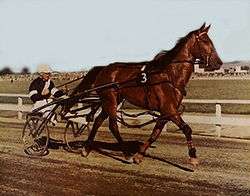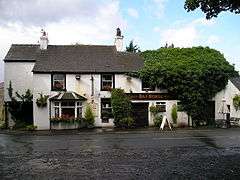
Cardigan Bay
Cardigan Bay (Welsh: Bae Ceredigion) is a large inlet of the Irish Sea, indenting the west coast of Wales between Bardsey Island, Gwynedd in the north, and Strumble Head, Pembrokeshire at its southern end. It is the largest bay in Wales.
Geography
Cardigan Bay has numerous beaches, and a unique marine life. Much of the coast surrounding the bay is fertile farmland, dotted with towns and seaside resorts such as Fishguard, New Quay, Aberaeron, Llanon, Aberystwyth, Borth, Aberdyfi, Tywyn, Barmouth, Porthmadog, Criccieth and Pwllheli on the Cambrian Coast.
Major rivers flowing into the bay include the Afon Glaslyn, Teifi, Rheidol, Dyfi, Aeron, Dysynni, and Mawddach.
History
Until the early 20th century, Cardigan Bay supported a strong maritime industry. Cardigan is located at the mouth of the River Teifi – hence the Welsh name, Aberteifi (Mouth of the Teifi), and at the turn of the 19th century, the heyday of the port, it was a more important port than Cardiff. At this time more than 300 ships were registered at Cardigan—seven times as many as Cardiff, and three times as many as Swansea.
Cardigan Bay (disambiguation)
Cardigan Bay is a bay in Wales.
Cardigan Bay may also refer to:

Cardigan Bay (horse)
Cardigan Bay was a New Zealand Harness racing horse foaled 1 September 1956. Affectionately known as "Cardy", he was the first Standardbred to win US$1 million in prize money in North America. He was the ninth horse worldwide to win one million dollars, (the first eight were Thoroughbreds). Cardigan Bay won races in New Zealand, Australia, Canada and the United States.
Along with his arch-rival, American champion of the day, Bret Hanover, he has a legitimate claim of being one of the truly great Standardbred racehorses. Cardigan Bay became an overnight sensation in the United States, and appeared with Dancer on The Ed Sullivan Show as the "million dollar horse".
Breeding
Cardigan Bay was foaled at Mataura (near Gore) in the South Island of New Zealand. As you drive into Mataura from Gore, there is a sign on the road proclaiming Mataura as the birthplace of Cardigan Bay. He was a first crop foal by a leading sire, Hal Tryax (USA), his dam Colwyn Bay was by Josedale Dictator (USA). Cardigan Bay was a brother to Thule Bay and a half-brother to Brides Bay.

Bay (horse)
Bay is a hair coat color of horses, characterized by a reddish-brown body color with a black mane, tail, ear edges, and lower legs. Bay is one of the most common coat colors in many horse breeds.
The black areas of a bay horse's hair coat are called "black points", and without them, a horse cannot be a bay. Black points may sometimes be covered by white markings; however such markings do not alter a horse's classification as "bay". Bay horses have dark skin, except under white markings - where the skin is pink. Genetically, bay occurs when a horse carries both the Agouti gene and a black base coat. The addition of other genes creates many additional coat colors. While the basic concepts behind bay coloring are fairly simple, the genes themselves and the mechanisms that cause shade variations within the bay family are quite complex and, at times, disputed. The genetics of dark shades of bay are still under study. A DNA test for seal brown has been developed, but sooty genetics also appear to darken some horse' bay coats, and that genetic mechanism is yet to be fully understood.

Bay Horse
Coordinates: 53°58′12″N 2°46′26″W / 53.970°N 2.774°W / 53.970; -2.774
Bay Horse is a sparsely populated hamlet in the English county of Lancashire. It lies between Lancaster and Preston to the north and south respectively.
Geography
To the west is the Irish Sea, and to the east is the Forest of Bowland, partly owned by the Royal Family.
Community
The local area is mostly farmland, the nearest large urban area being Lancaster, approximately five miles away. Approximately 100 inhabitants reside in Bay Horse. The main road through Bay Horse is Whams Lane, which is used by motorcyclists on their way to Devils Bridge at Kirkby Lonsdale.
Travel
The Lancaster Canal bisects the village, and the M6 motorway runs though the village.
Bay Horse railway station closed due to low usage in the 1960s.
Pub
There are no amenities in the village, just a single pub, the Bay Horse Inn, after which the village is named. Even though the boundaries of Bay Horse are uncertain, there is a riding school on the outskirts called Bay Horse School.
Podcasts:

